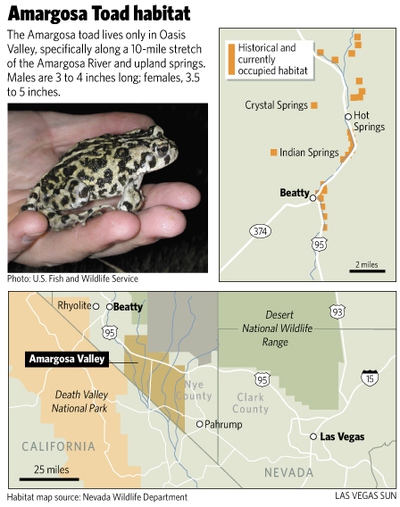Friday, Sept. 11, 2009 | 2 a.m.
Sun Archives
- Environmentalists try to block Yucca water rights request (4-13-2009)
- Amargosa toad protection sought in lawsuit (3-11-2009)
- Protection sought for Amargosa Toad (2-26-2008)
Beyond the Sun
First came the fish, now it’s the toads.
The obstacles thrown at solar developers in Nevada these days are practically biblical.
As solar companies’ applications for leases on federal lands finally move into the environmental review stages, developers are seeing a new potential snag: federally protected species.
But it’s not the obvious ones — not desert tortoises, not the Las Vegas Buckwheat. Solar developers hoping to build plants in the Amargosa Valley are facing potential troubles from the likes of the Devil’s Hole pupfish and the Amargosa toad.
The U.S. Fish and Wildlife Service announced Thursday that it is examining whether a rare toad that lives only in the springs near Beatty should be listed as a threatened or endangered species.
The Amargosa amphibian in question lives only in a 10-mile stretch of river and wetlands in the Oasis Valley between Beatty and Springdale. It has been classified as a protected species by Nevada since 1998 and has been closely watched by federal authorities since the late 1970s.
The Center for Biological Diversity and the Public Employees for Environmental Responsibility were concerned that not enough was being done to formally protect the toad and in February 2008 filed a petition with Fish and Wildlife seeking federal protection for the species.
These groups claim the toad’s habitat is threatened by planned development, increased ground water pumping and other activity by new residents as well as new stresses on the water table from several utility-scale solar developments planned in nearby Amargosa Valley.
The toad needs stable wetlands that support both mating and insect hunting. The solar developers need water to clean, and in some cases cool, their electric plants.
The state engineer in 1998 declared that more water rights had been allocated in the Oasis Valley than actually existed. Conservationists and locals contend the aquifer under the Oasis Valley is connected to those in other valleys along the western part of the state, so any major water extraction in one valley would affect springs in the other.
The impact of thousands of acres of solar arrays could be huge, said Rob Mrowka, an ecologist and conservation advocate for the Center for Biological Diversity, one of the organizations that petitions Fish and Wildlife to analyze the threat to the toad.
The level of trouble these endangered or sensitive species could cause for solar developers depends largely on the amount of water the solar plants want to take from the area. A solar photovoltaic plant needs only enough water to wash the panels a few times a year and run water in the plant’s lavatory, the solar industry says. But a single water-cooled solarthermal plant could consume up to 2,000 acre-feet of water a year — enough to support more than 4,000 average Las Vegas homes.
Numerous solar plants of all types are planned for the Amargosa Valley area, but so far the only one that has begun the environmental review process with the Bureau of Land Management is Solar Millennium’s. The plant was proposed with water cooling technology in mind, but the company is also open to using air cooling technology if water resources are a problem, said Jason Higgins, project director for the plant.
“The biological surveys are being analyzed now,” he said. “There are several species of concern up there and those impacts are being analyzed. Any findings will come out in the draft environmental impact statement sometime around January.”
Because of the state protection, the potential impact on the toad by this plant or the cumulative impact of several plants must be considered in the projects’ environmental review. The BLM will ensure any potential impacts on the toad or other sensitive species that depend on the ground water, such as the pupfish, will be analyzed in the environmental review.


Join the Discussion:
Check this out for a full explanation of our conversion to the LiveFyre commenting system and instructions on how to sign up for an account.
Full comments policy